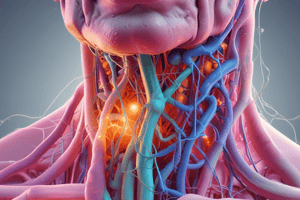Podcast
Questions and Answers
What does the 'S' in SLUDGEM stand for?
What does the 'S' in SLUDGEM stand for?
- Sweating
- Salivation (correct)
- Seizures
- Shaking
What does the 'L' in SLUDGEM indicate?
What does the 'L' in SLUDGEM indicate?
- Lethargy
- Leg cramps
- Loss of consciousness
- Lacrimation (correct)
What is represented by the 'U' in SLUDGEM?
What is represented by the 'U' in SLUDGEM?
- Urination (correct)
- Uvula swelling
- Urticaria
- Unconsciousness
What does the 'D' in SLUDGEM stand for?
What does the 'D' in SLUDGEM stand for?
What is the meaning of 'G' in SLUDGEM?
What is the meaning of 'G' in SLUDGEM?
What does the 'E' in SLUDGEM refer to?
What does the 'E' in SLUDGEM refer to?
What does 'M' represent in the SLUDGEM acronym?
What does 'M' represent in the SLUDGEM acronym?
What does SLUDGEM encompass?
What does SLUDGEM encompass?
Flashcards are hidden until you start studying
Study Notes
SLUDGEM Acronym - Symptoms of Nerve Agents
- SLUDGEM is an acronym used to identify symptoms caused by exposure to nerve agents.
- Each letter in SLUDGEM represents a distinct physiological response.
Breakdown of Acronym
- S: Salivation - Excessive production of saliva, often leading to drooling.
- L: Lacrimation - Increased tear production, which results in watery eyes.
- U: Urination - Frequent urination due to overstimulation of the bladder.
- D: Defecation - Increased bowel movement or involuntary defecation.
- G: GI upset - Gastrointestinal disturbances, including cramps and diarrhea.
- E: Emesis - Vomiting, which is a common response to toxic exposure.
- M: Miosis - Constriction of the pupils, making them abnormally small.
Summary of Symptoms
- Salivation, lacrimation, urination, defecation, gastrointestinal upset, emesis, and miosis collectively signify the effects of nerve agent exposure and warrant urgent medical attention.
Studying That Suits You
Use AI to generate personalized quizzes and flashcards to suit your learning preferences.





